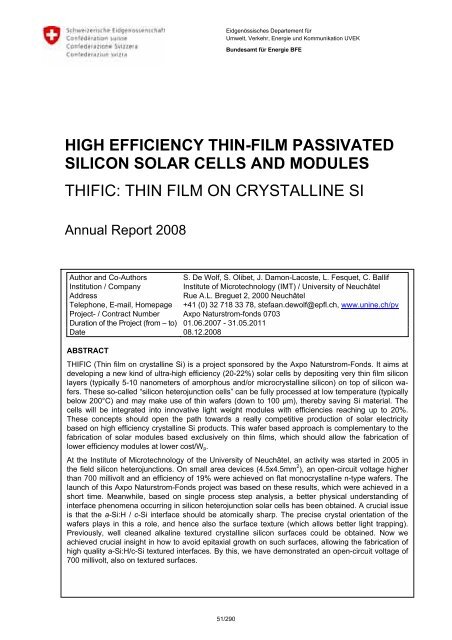Programm Photovoltaik Ausgabe 2009 ... - Bundesamt für Energie BFE
Programm Photovoltaik Ausgabe 2009 ... - Bundesamt für Energie BFE
Programm Photovoltaik Ausgabe 2009 ... - Bundesamt für Energie BFE
Create successful ePaper yourself
Turn your PDF publications into a flip-book with our unique Google optimized e-Paper software.
Eidgenössisches Departement <strong>für</strong><br />
Umwelt, Verkehr, <strong>Energie</strong> und Kommunikation UVEK<br />
<strong>Bundesamt</strong> <strong>für</strong> <strong>Energie</strong> <strong>BFE</strong><br />
HIGH EFFICIENCY THIN-FILM PASSIVATED<br />
SILICON SOLAR CELLS AND MODULES<br />
THIFIC: THIN FILM ON CRYSTALLINE SI<br />
Annual Report 2008<br />
Author and Co-Authors S. De Wolf, S. Olibet, J. Damon-Lacoste, L. Fesquet, C. Ballif<br />
Institution / Company Institute of Microtechnology (IMT) / University of Neuchâtel<br />
Address Rue A.L. Breguet 2, 2000 Neuchâtel<br />
Telephone, E-mail, Homepage +41 (0) 32 718 33 78, stefaan.dewolf@epfl.ch, www.unine.ch/pv<br />
Project- / Contract Number Axpo Naturstrom-fonds 0703<br />
Duration of the Project (from – to) 01.06.2007 - 31.05.2011<br />
Date 08.12.2008<br />
ABSTRACT<br />
THIFIC (Thin film on crystalline Si) is a project sponsored by the Axpo Naturstrom-Fonds. It aims at<br />
developing a new kind of ultra-high efficiency (20-22%) solar cells by depositing very thin film silicon<br />
layers (typically 5-10 nanometers of amorphous and/or microcrystalline silicon) on top of silicon wafers.<br />
These so-called “silicon heterojunction cells” can be fully processed at low temperature (typically<br />
below 200°C) and may make use of thin wafers (down to 100 µm), thereby saving Si material. The<br />
cells will be integrated into innovative light weight modules with efficiencies reaching up to 20%.<br />
These concepts should open the path towards a really competitive production of solar electricity<br />
based on high efficiency crystalline Si products. This wafer based approach is complementary to the<br />
fabrication of solar modules based exclusively on thin films, which should allow the fabrication of<br />
lower efficiency modules at lower cost/Wp.<br />
At the Institute of Microtechnology of the University of Neuchâtel, an activity was started in 2005 in<br />
the field silicon heterojunctions. On small area devices (4.5x4.5mm 2 ), an open-circuit voltage higher<br />
than 700 millivolt and an efficiency of 19% were achieved on flat monocrystalline n-type wafers. The<br />
launch of this Axpo Naturstrom-Fonds project was based on these results, which were achieved in a<br />
short time. Meanwhile, based on single process step analysis, a better physical understanding of<br />
interface phenomena occurring in silicon heterojunction solar cells has been obtained. A crucial issue<br />
is that the a-Si:H / c-Si interface should be atomically sharp. The precise crystal orientation of the<br />
wafers plays in this a role, and hence also the surface texture (which allows better light trapping).<br />
Previously, well cleaned alkaline textured crystalline silicon surfaces could be obtained. Now we<br />
achieved crucial insight in how to avoid epitaxial growth on such surfaces, allowing the fabrication of<br />
high quality a-Si:H/c-Si textured interfaces. By this, we have demonstrated an open-circuit voltage of<br />
700 millivolt, also on textured surfaces.<br />
51/290







